| Listing 1 - 10 of 12 | << page >> |
Sort by
|
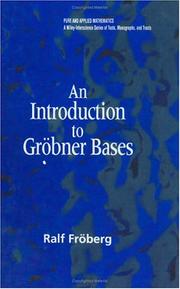
ISBN: 0471974420 9780471974420 Year: 1997 Publisher: Chichester: Wiley,
Abstract | Keywords | Export | Availability | Bookmark
 Loading...
Loading...Choose an application
- Reference Manager
- EndNote
- RefWorks (Direct export to RefWorks)
Gröbner bases --- Ordered algebraic structures --- Algèbres commutatives
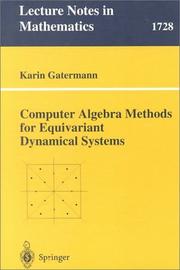
ISBN: 3540671617 Year: 2000 Publisher: Berlin ; Heidelberg ; New York Springer
Abstract | Keywords | Export | Availability | Bookmark
 Loading...
Loading...Choose an application
- Reference Manager
- EndNote
- RefWorks (Direct export to RefWorks)
Algebra --- Data processing --- Gröbner bases --- Differentiable dynamical systems
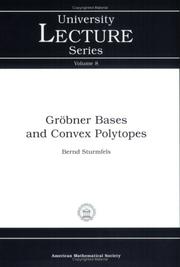
ISBN: 0821804871 9780821804872 Year: 1996 Volume: 8 Publisher: Providence (R.I.) : American mathematical society,
Abstract | Keywords | Export | Availability | Bookmark
 Loading...
Loading...Choose an application
- Reference Manager
- EndNote
- RefWorks (Direct export to RefWorks)
Ordered algebraic structures --- Gröbner bases --- Convex polytopes --- 512.62 --- Grobner bases --- Polytopes --- Gröbner basis theory --- Commutative algebra --- Fields. Polynomials --- Convex polytopes. --- Gröbner bases. --- 512.62 Fields. Polynomials --- Gröbner bases
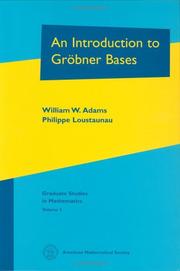
ISBN: 0821838040 9780821838044 Year: 1996 Volume: 3 Publisher: Providence: American mathematical society,
Abstract | Keywords | Export | Availability | Bookmark
 Loading...
Loading...Choose an application
- Reference Manager
- EndNote
- RefWorks (Direct export to RefWorks)
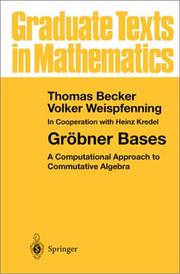
ISBN: 0387979719 3540979719 9780387979717 Year: 1993 Volume: 141 Publisher: New York (N.Y.): Springer,
Abstract | Keywords | Export | Availability | Bookmark
 Loading...
Loading...Choose an application
- Reference Manager
- EndNote
- RefWorks (Direct export to RefWorks)
Gröbner bases --- ALGEBRA --- data processing --- Grobner bases. --- Grobner bases --- Gröbner basis theory --- Bases de Gröbner --- Gröbner bases --- Bases de Gröbner --- Algebra --- 512.55 --- 512.55 Rings and modules --- Rings and modules --- Commutative algebra --- Data processing --- Ordered algebraic structures --- Data processing. --- Algèbre --- Informatique --- Geometry, Algebraic --- Géométrie algébrique. --- Algorithms --- Algorithmes. --- Algèbres commutatives --- Algebra - Data processing. --- ALGEBRA - data processing --- Algèbres commutatives --- Géométrie algébrique.
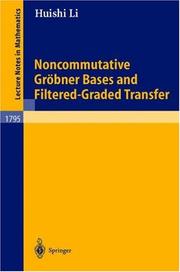
ISSN: 00758434 ISBN: 3540441964 3540457658 9783540441960 Year: 2002 Volume: 1795 Publisher: Berlin: Springer,
Abstract | Keywords | Export | Availability | Bookmark
 Loading...
Loading...Choose an application
- Reference Manager
- EndNote
- RefWorks (Direct export to RefWorks)
This self-contained monograph is the first to feature the intersection of the structure theory of noncommutative associative algebras and the algorithmic aspect of Groebner basis theory. A double filtered-graded transfer of data in using noncommutative Groebner bases leads to effective exploitation of the solutions to several structural-computational problems, e.g., an algorithmic recognition of quadric solvable polynomial algebras, computation of GK-dimension and multiplicity for modules, and elimination of variables in noncommutative setting. All topics included deal with algebras of (q-)differential operators as well as some other operator algebras, enveloping algebras of Lie algebras, typical quantum algebras, and many of their deformations.
Associative rings --- Grobner bases. --- ALGEBRA --- Filtered rings. --- Gröbner bases --- Algebra --- Filtered rings --- Data processing. --- data processing. --- Data processing --- Grèobner bases --- Mathematical Theory --- Mathematics --- Physical Sciences & Mathematics --- Associative rings. --- Rings (Algebra). --- Algorithms. --- Associative Rings and Algebras. --- Algorism --- Arithmetic --- Algebraic rings --- Ring theory --- Algebraic fields --- Rings (Algebra) --- Foundations --- Associative rings - Data processing. --- ALGEBRA - data processing. --- Algebra - Data processing
Book
ISBN: 311090974X 9783110909746 3110193337 9783110193336 Year: 2007 Publisher: Berlin ; New York : Walter de Gruyter,
Abstract | Keywords | Export | Availability | Bookmark
 Loading...
Loading...Choose an application
- Reference Manager
- EndNote
- RefWorks (Direct export to RefWorks)
This volume contains survey and original articles presenting the state of the art on the application of Gröbner bases in control theory and signal processing. The contributions are based on talks delivered at the Special Semester on Gröbner Bases and Related Methods at the Johann Radon Institute of Computational and Applied Mathematics (RICAM), Linz, Austria, in May 2006.
Gröbner bases. --- Control theory. --- Signal processing. --- Processing, Signal --- Information measurement --- Signal theory (Telecommunication) --- Dynamics --- Machine theory --- Gröbner basis theory --- Commutative algebra --- Algebras. --- base. --- control theory. --- signal theory. --- Grobner bases.
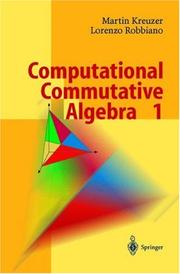
ISBN: 354067733X 3540255273 3540706283 3642064914 3540282963 9783540677338 9783540255277 Year: 2005 Publisher: Berlin, Heidelberg : Springer Berlin Heidelberg : Imprint: Springer,
Abstract | Keywords | Export | Availability | Bookmark
 Loading...
Loading...Choose an application
- Reference Manager
- EndNote
- RefWorks (Direct export to RefWorks)
Computational Commutative Algebra 2 is the natural continuation of Computational Commutative Algebra 1 with some twists, starting with the differently coloured cover graphics. The first volume had 3 chapters, 20 sections, 44 tutorials, and some amusing quotes. Since bigger is better, this book contains 3 chapters filling almost twice as many pages, 23 sections (some as big as a whole chapter), and 55 tutorials (some as big as a whole section). The number of jokes and quotes has increased exponentially due to the little-known fact that a good mathematical joke is better than a dozen mediocre papers. The main part of this book is a breathtaking passeggiata through the computational domains of graded rings and modules and their Hilbert functions. Besides Gröbner bases, we encounter Hilbert bases, border bases, SAGBI bases, and even SuperG bases. The tutorials traverse areas ranging from algebraic geometry and combinatorics to photogrammetry, magic squares, coding theory, statistics, and automatic theorem proving. Whereas in the first volume gardening and chess playing were not treated, in this volume they are. This is a book for learning, teaching, reading, and most of all, enjoying the topic at hand. The theories it describes can be applied to anything from children's toys to oil production. If you buy it, probably one spot on your desk will be lost forever!
Gröbner bases --- Commutative algebra --- Grobner, Bases de --- Algebre commutative --- Data processing --- Informatique --- Commutative algebra -- Data processing. --- Gröbner bases. --- Gröbner basis theory --- Mathematics. --- Computer science --- Algebra. --- Algebraic geometry. --- Computer mathematics. --- Algorithms. --- Computational Mathematics and Numerical Analysis. --- Symbolic and Algebraic Manipulation. --- Algebraic Geometry. --- Data processing. --- Algebra --- Geometry, algebraic. --- Algebraic geometry --- Geometry --- Computer mathematics --- Discrete mathematics --- Electronic data processing --- Algorism --- Arithmetic --- Mathematics --- Mathematical analysis --- Foundations --- Combinatorial analysis. --- QA 150-272 Algebra. --- Computer science—Mathematics. --- Group theory. --- Group Theory and Generalizations. --- Groups, Theory of --- Substitutions (Mathematics) --- Commutative algebra - Data processing --- Algebre commutative - Informatique --- Geometry, Algebraic.
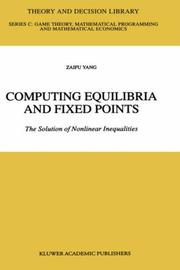
ISBN: 0792383958 1441950702 1475748396 9780792383956 Year: 1999 Volume: 21 Publisher: Boston: Kluwer,
Abstract | Keywords | Export | Availability | Bookmark
 Loading...
Loading...Choose an application
- Reference Manager
- EndNote
- RefWorks (Direct export to RefWorks)
Computing Equilibria and Fixed Points is devoted to the computation of equilibria, fixed points and stationary points. This volume is written with three goals in mind: (i) To give a comprehensive introduction to fixed point methods and to the definition and construction of Gröbner bases; (ii) To discuss several interesting applications of these methods in the fields of general equilibrium theory, game theory, mathematical programming, algebra and symbolic computation; (iii) To introduce several advanced fixed point and stationary point theorems. These methods and topics should be of interest not only to economists and game theorists concerned with the computation and existence of equilibrium outcomes in economic models and cooperative and non-cooperative games, but also to applied mathematicians, computer scientists and engineers dealing with models of highly nonlinear systems of equations (or polynomial equations).
Fixed point theory --- Game theory --- Jeux [Théorie des ] --- Point fixe [Théorème du ] --- Speltheorie --- Theorie van het vaste punt --- Théorie des jeux --- Théorème du point fixe --- Gröbner bases --- Economic theory. --- Economic Theory/Quantitative Economics/Mathematical Methods. --- Economic theory --- Political economy --- Social sciences --- Economic man
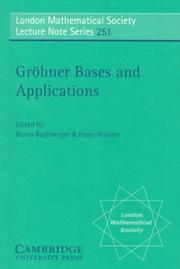
ISBN: 113988543X 1107365147 1107362695 1107367603 110737216X 1107369355 0511565844 9781107362697 9780511565847 0521632986 9780521632980 Year: 1998 Publisher: Cambridge Cambridge University Press
Abstract | Keywords | Export | Availability | Bookmark
 Loading...
Loading...Choose an application
- Reference Manager
- EndNote
- RefWorks (Direct export to RefWorks)
The theory of Gröbner bases, invented by Bruno Buchberger, is a general method by which many fundamental problems in various branches of mathematics and engineering can be solved by structurally simple algorithms. The method is now available in all major mathematical software systems. This book provides a short and easy-to-read account of the theory of Gröbner bases and its applications. It is in two parts, the first consisting of tutorial lectures, beginning with a general introduction. The subject is then developed in a further twelve tutorials, written by leading experts, on the application of Gröbner bases in various fields of mathematics. In the second part are seventeen original research papers on Gröbner bases. An appendix contains the English translations of the original German papers of Bruno Buchberger in which Gröbner bases were introduced.
Gröbner bases. --- Coding theory --- Gröbner basis theory --- Commutative algebra --- Geometry, Algebraic --- Géométrie algébrique. --- Algorithms --- Algorithmes. --- Anneaux de polynômes. --- Polynomial rings. --- Algèbres commutatives. --- Polynômes --- Polynomials --- 512.56 --- 512.56 Lattices, including Boolean rings and algebras --- Lattices, including Boolean rings and algebras --- Grobner bases. --- Géométrie algébrique --- Algorithmes --- Anneaux de polynômes. --- Algèbres commutatives. --- Polynômes
| Listing 1 - 10 of 12 | << page >> |
Sort by
|

 Search
Search Feedback
Feedback About UniCat
About UniCat  Help
Help News
News